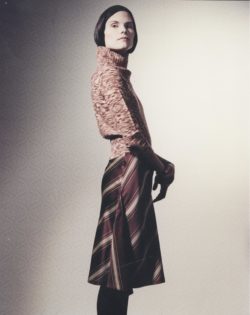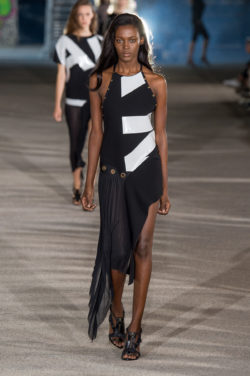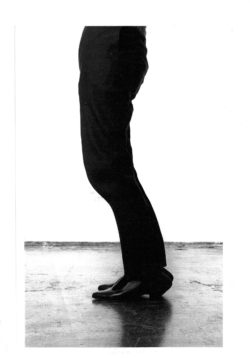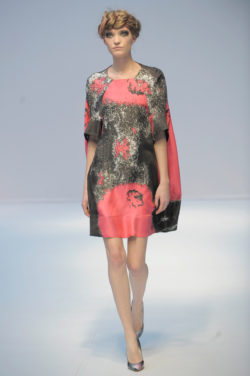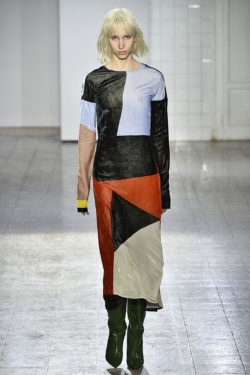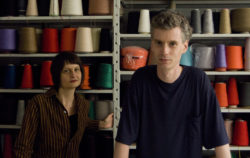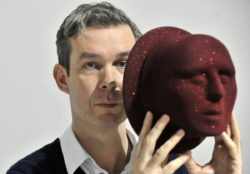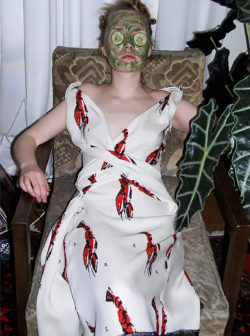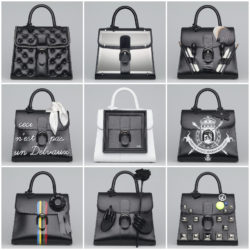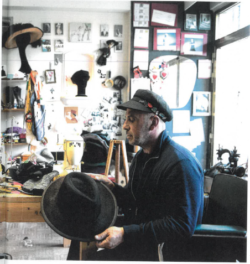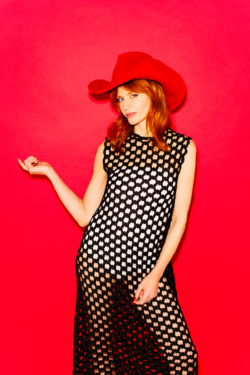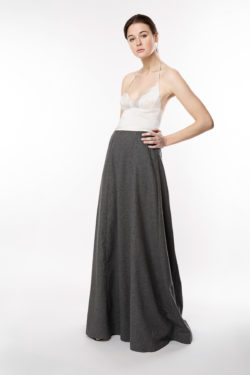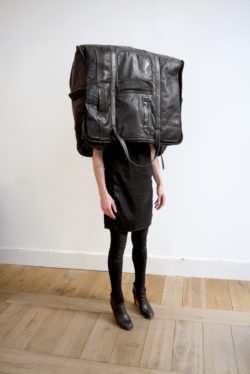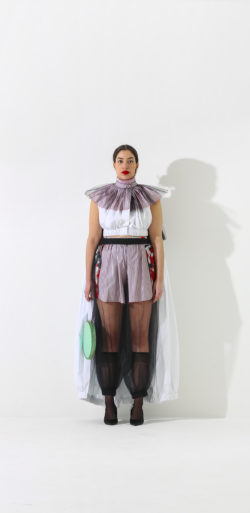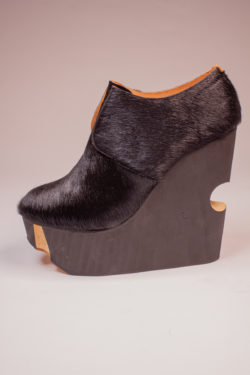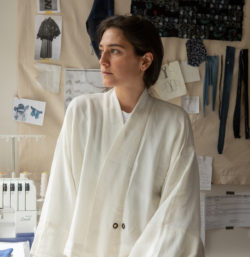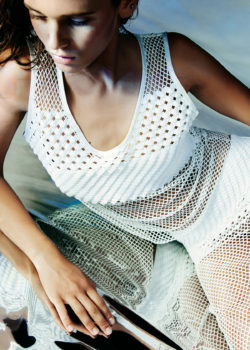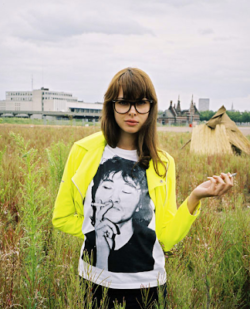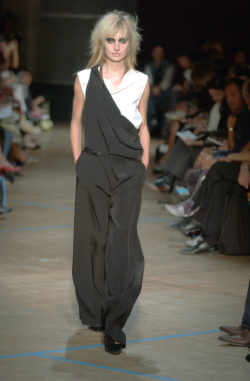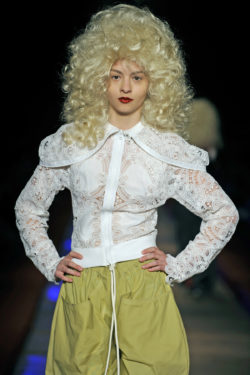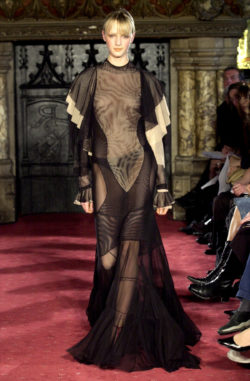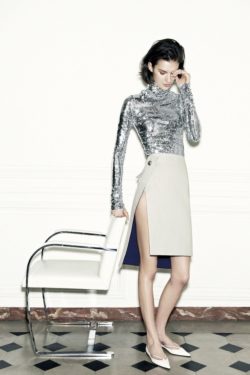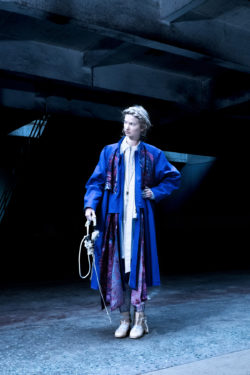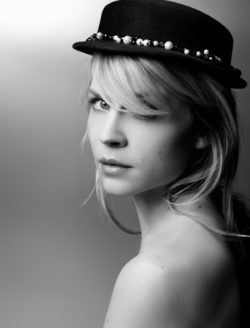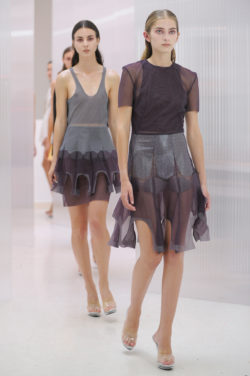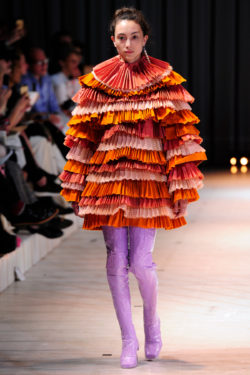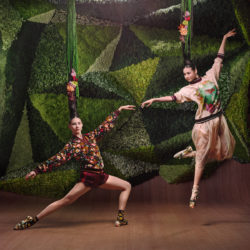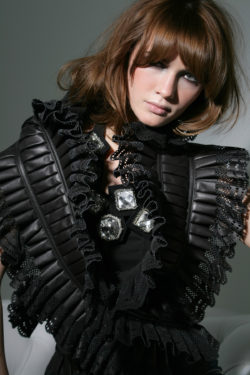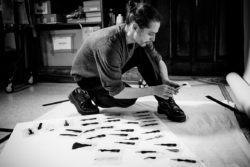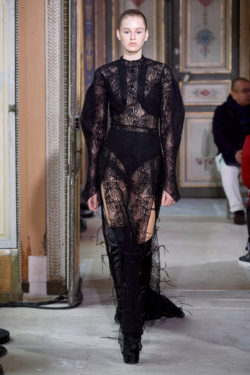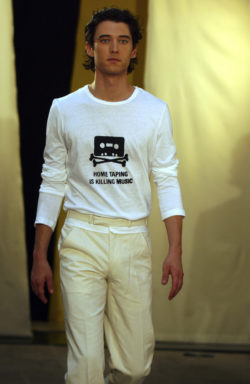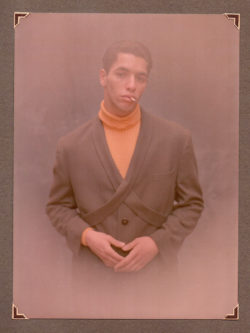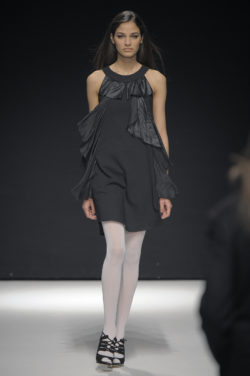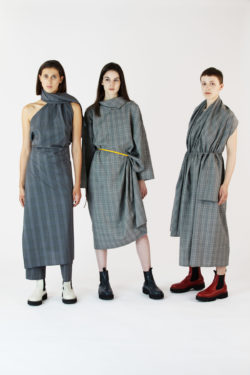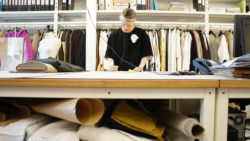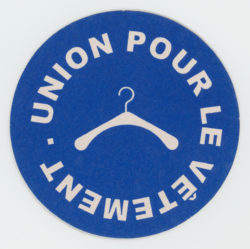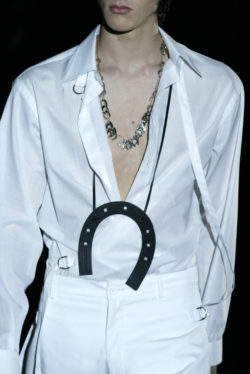Timeline: Brussels touch
References
In alphabetical order
Annemie Verbeke
© Michel Durant _ Archives Annemie Verbeke
Gentle, feminine poetics, an intimate world, an alchemy of allure, a touch of retro.
The ostensibly simple clothes that Annemie Verbeke (b. 1953) designs promise the perfect balance between comfortable materials, wearability and her unique and subtle art of colour and pattern compositions. Famous for her expertise in knitwear, she has trained many designers in this art at La Cambre.
Anthony Vaccarello
The precision of asymmetric cuts, the body boldly revealed, and classic rock n’ roll blacks. Anthony Vaccarello (b. 1982) infuses his creations with an element of tension, an implicit erotic intensity, a Latin soul combined with a very personal sense of discretion. This style is perceptible as much in his namesake label as in his work as Creative Director for Versace’s Versus line (2015-2016) and Saint Laurent (since 2016).
© CatwalkPictures, Etienne Tordoir, Anthony Vaccarello SS2015
Beauduin Masson
©Vincent.Lehon_Beauduin-Masson FW 1996-1997
A passion for the architectural dimension of garment design and an appreciation for materials with historical significance drive the joint creations of Éric Beauduin (1968-2018) and Anne Masson (b. 1969).
Their S-shaped pair of trousers that eliminates conventional side seams – and which became their signature since it was developed in 1993 – has inspired major brands from Comme des Garçons to Diesel. From their modular pieces with adjustable waists, to their innovative knits and extravagantly curved shoe designs, a same spirit of research and a singular art of pattern-making hallmark this duo trained at La Cambre, one in fashion design, the other in textiles.
Cathy Pill
Light, diaphanous garments whose experimental take on pattern graces the eye like shifting tableaux. Cathy Pill (b. 1981) pushes the creation of original prints to the extreme, reworking images to the point of abstraction. Meticulously placed to support the cut of the garment, the graphic result cadences the flow of a supple drape and the movement of skilfully placed gathers.
© CatwalkPictures, Etienne Tordoir
Cédric Charlier
© CatwalkPictures, Etienne Tordoir_Cedric Charlier FW 2017-2018
A highly personal chromatic universe penetrates his soft,
yet utterly graphic, silhouettes like the reminiscence of emotions triggered by contemporary painting. The collections of Cédric Charlier (b. 1978) have
a distinctly fresh, natural allure, a new elegance, manifest also in his collaborations with brands such as Cacharel or Petit Bateau, a token of the generous nature of his creative palette.
Chevalier Masson
© Lise Duclaux_portrait Eric Chevalier & Anne Masson
Knits are central to the work of this duo formed by textile designers Anne Masson (b. 1969), a Swiss native, and French born Éric Chevalier (b. 1974). Exploring myriad production techniques, from the most traditional to the most cutting-edge, they apply their innovative vision to the design of wearable (and non-wearable) accessories imbued with a facetious spirit and new functionalities. Their original approach to an article as banal and modest as a sock, is in this respect, exemplary. In 2000, Anne Masson was named head of the Atelier de Design Textile de La Cambre, where Éric Chevalier teaches since 2004.
Christophe Coppens
© Getty Images, Gordon Stabbins
The hats and couture accessories designed by this artist-turned-milliner reflect only part of
his rich universe. Appreciated by the Belgian Royal Family
as much as by performing artists of the likes of Róisín Murphy, Christophe Coppens (b. 1969) is a storyteller of outlandish tales. Regularly presented in highly personal exhibitions,
his unclassifiable creations infuse the world of fashion with the spirit of contemporary art.
David Szeto
Supple drape, skilfully placed gathers, and pleats that flatter the silhouette without constraint, David Szeto (b. 1967) applies his art of cutting on the bias to achieve an elaborate form of simplicity. Here, this true connoisseur of couture’s great masters pays tribute to the surrealist spirit of Elsa Schiaparelli, whose lobster print dress, created with Salvador Dalí in 1937, has made history. Worn by Wallis Simpson shortly before she became the Duchess of Windsor, this dress was captured by Cecil Beaton in a photo-reportage published in Vogue in June 1937.
© Hanna Kaiser Korolainen_David Szeto_FW 2004-2005
Delvaux
© Delvaux
The craftsmanship and excellence of a Belgian leather goods house founded nearly two hundred years ago has, since the 1950s, also shaped the world of fashion with the creation of a now iconic line of bags that includes the famed “Brillant”. Throughout the 21st century, Delvaux has entrusted its creative direction to fashion designers (Laetitia Crahay in 2003, Didier Vervaeren in 2006, to cite but two). Infusing the house’s great classics with their surrealistic Belgian hallmark and creating new lines, they have helped put Delvaux on the map of the international luxury market.
Elvis Pompilio
His one-piece moulded cap is his signature and ultimately his logotype. No interior grosgrain ribbon encumbers the supple hats Elvis Pompilio (b. 1961) designs. Some are transformable, others, like his knitted models, are akin to miniature garments. Since 1987, this non-conformist milliner has been designing a vast array of headpieces for international stars and national luminaries including Axelle Red and Amélie Nothomb, whose favourite Diabolo hat he designed.
© Alex Salinas, Elvis Pompilio in Weekend LeVif n°10-2019
© CatwalkPictures,-Etienne-Tordoir
Emmanuel Laurent
© Emmanuel Laurent_FW 1995-1995
Pared lines forming a sharp silhouette not without lyricism. Emmanuel Laurent (b. 1969) practices the art of hybridisation, scrambled codes and references, in a retro spirit knowing no nostalgia. This ensemble pairing a 1950s-inspired bustier with a skirt cut in a men’s suiting fabric is emblematic of his work. He was among the first generation of La Cambre Mode(s) graduates to triumph at the Hyères Festival (1991 and 1994). In 2001 he shuttered his namesake brand to pursue a career in fashion photography.
Eric Beauduin
After designing clothes and shoes for the Beauduin-Masson label, this artist-artisan turned to bags as his preferred field of expression. He pioneered the art of upcycling leather goods, crafting one-off pieces and numbered series out of vintage leather garments meticulously dissected in his Brussels studio. Each and every bag designed by Éric Beauduin (1968-2018) features skilfully repositioned functional details, pockets, belts and buckles that have become his hallmark. The work of this discreet and committed visionary testifies to an original, lucid, and responsible approach to fashion.
© Pam & Jenny
Ester Manas
© Ester Manas 2008
These one-size-fits-all clothes feature cleverly positioned buttons, ties and smocked details, or are made in a knit fabric specifically designed to adapt to every body shape (covering sizes 34-50). One size fits all is the manifesto-slogan upheld with style by the design duo formed by French-born Ester Manas (b. 1992) and Brussels native Balthazar Delepierre (b. 1993), who are also vocal supporters of a more responsible fashion industry.
Éts Callatay
A single piece of fine leather skilfully folded and pressed, forms his shoes. It is an atypical approach, similar to certain masters of haute couture, which he developed in the Parisian studio he opened in 2011. Trained in industrial design, Joachim de Callataÿ (b. 1979) applies its principles to the design and fabrication of his footwear. The platforms he carves from soft woods, the skins he hand-dyes in delicate colours, lend his shoes a metaphysical presence.
© Musée Mode & Dentelle_Ets Callatay FW_2010-2011
Gioia Seghers
© Anne-Sophie Guillet_Portrait Gioia Seghers 2021
© Gioia Seghers_SS 2005
Using the kimono as inspiration, updated by metal eyelets that have become her signature. A creative dialogue with an array of materials ranging from lace to knits, leather to passementerie ribbons and a love of handcrafts. The appeal and tactile nature of Gioia Seghers’ (b. 1988) creations elevate her instinctive approach to garment design.
Girls from Omsk
A fun and sexy attitude, fluorescent colours, a punk spirit with a sense of humour, and fanciful streetwear. Prints featuring Russian cultural icons, as here, the image of Viktor Tsoï, singer of the mythical alternative rock group Kino and leading figure of the pre-perestroika underground. Girls from Omsk – aka OMSK – was named after the birthplace of the father of Valeria Siniouchkina (b. 1977), cofounder of the label with graphic designer Philippe Koeune (b. 1975). Its collections radiate a very special, elegant and unpretentious energy.
© Girls from OMSK_SS 2009
Jean-Paul Knott
© CatwalkPictures, Etienne Tordoir_Jean-Paul Knott_SS 2003
Pure lines, elegant pieces and geometric constructions whose rigour dissolves into fluid drapes. With intelligence, simplicity and tenacity, the discreet Jean-Paul Knott (b. 1966) builds his clothes around an allure present in both his eponymous collections and his collaborations with such eminent international houses such as Yves Saint Laurent (1986-1999), Krizia (2002), Louis Féraud (2003) and Cerruti (2007-2009). With typical Belgian humility, he describes fashion as “transcribing a part of current events”.
Jean-Paul Lespagnard
Kitsch, glamour, design, social movements, overconsumption, religious imagery, pin-ups, toys, eroticism and the carefree attitude of the 1950s: Jean-Paul Lespagnard (b. 1979) has a taste for paradox and curiosity aplenty. Drawing his vision of the Extra-Ordinaire (the name of his Brussels store, a modern curiosity cabinet) from popular art and culture, his is a unique, syncretic fashion, not lacking in humour. His expert craftsmanship brings his sense of derision to life in pieces ranging from repurposed doilies (purchased at the Galerie de la Reine) to his beaded prawns, lobsters and strings of sausages.
© CatwalkPictures, Etienne Tordoir_ Jean-Paul Lespagnard_Festival d’Hyères 2008
José Enrique Ona Selfa
José Enrique Oña Selfa_aw01
The energy of dance is ubiquitous in the creations of Belgian-Spanish designer José Enrique Oña Selfa (b. 1975). The easy elasticity of knits, bias cuts that defy the laws of pattern-making, spontaneous flounces that exalt the body’s movement. His is an allure that expresses femininity with presence and panache, the same qualities that contributed, under his creative direction (2001-2007), to elevate the eminent Madrid house Loewe on the international fashion scene.
Julien Dossena
Technical fabrics and shapes designed for action, first developed for his label ATTO (2012-2014), then coupled with the emblematic chainmail and Rhodoid disks of Paco Rabanne, for whom he has been Creative Director since 2013. Born in Brittany and trained at La Cambre Mode(s), Julien Dossena’s (b. 1982) vision of femininity is that of a relaxed and sophisticated free spirit.
He is a proponent of radical simplicity that conveys an unostentatious sensuality, delivers surprising effects, but remains easy and accessible, allowing any and every woman to adopt his clothes as her own.
Julien Dossena
KRJST
© Sébastien Delahaye_KRJST FW 2013-2014
Tapestry, weaving, jacquard knitting, screen printing, among many other experimental practices. Erika Schillebeeckx (b. 1988)
and Justine de Moriamé (b. 1986) employ myriad techniques with one goal in mind: to create
a textile phantasmagoria rich in colourful compositions and textured patterns. Their clothing, unique by essence, possesses that singular touch that encourages the art of putting oneself on show.
Laetitia Crahay
With the keen sense of timing she employs for luxury houses – notably the house of Chanel,
whose accessories and jewellery she administered under the protective eye of Karl Lagerfeld – Lætitia Crahay (b. 1976) introduced an aura of fashion, a sense of humour, and a light-hearted note into the Maison Michel (2006-2015). Intertwining traditional savoir-faire and surrealistic touches, her lace rabbit- and cat-ear head accessories have become essentials and her little felt hats flecked with beads and her mysterious hat veils, indispensable.
© Maison Michel, Photo Karl Lagerfeld_ Clémence Poésy
Léa Peckre
© CatwalkPictures, Etienne Tordoir _ Lea Peckre SS 2014
Garments akin to supple sculptures, diaphanous dresses crafted in layers of coloured strata and geometric cuts. Volumes skilfully elaborated through a plastic approach to the fabric and for which the body serves as support. Born in France and trained at La Cambre Mode(s), Léa Peckre (b. 1984) possesses an elevated sense of artistry and a pronounced taste for experimentation.
Marine Serre
Born in France and trained at La Cambre Mode(s), Marine Serre (b. 1991) has made sustainability and circularity in fashion the foundation of her practice. Regeneration, the key notion that drives her vision and creative process, embraces the entire design and manufacturing cycle: from the stock of garments, rugs, scarves and other elements to be recycled into raw materials, to the production and distribution of these non-elitist and by their very essence unique pieces. Her debut collection in 2017, “Radical Call for Love”, was her response to the terrorist attacks of 2015, and ushered in her print-turned-logo crescent moon inspired by Arab culture. That same year, Marine Serre received the prestigious LVMH award.
© CatwalkPictures, Etienne Tordoir_Marine Serre 2015
Mosaert
© Antoine Melis, Mosaert 2017
A versatile artistic collective producing music, videos and ready-to-wear, the Mosaert label is a family affair created in 2014 by Paul Van Haver (b. 1985), better known as Stromae, his brother
Luc Junior Tam and the singer’s wife, Coralie Barbier (b. 1984). In their vivid universe, rich in colours and original patterns, they present their collections in the form of capsules, each having a limited number of genderless pieces.
Olivia Hainaut
Craftsmanship, sophistication and rock n’ roll. Olivia Hainaut
(b. 1967) creates unique jewellery, ruffs, stoles, tunics and scarves by transforming wood, resin, metal, leather and chains.
In addition to her handcrafted work, her accessibly priced badges, featuring offbeat messages and plays on words, is one of her great successes. And a poetic tribute to Belgian humour.
© Charalambos Gagalis, Olivia Hainaut 2018
Olivier Theyskens
© Claessens-Deschamps, portrait Olivier Theyskens
© CatwalkPictures, Etienne Tordoir, Olivier Theyskens FW 2019-2020
Artistic sensitivity coupled with a scientific mind, technical excellence serving a poetic purpose. The work of Olivier Theyskens (b. 1977) is penetrated by a great freedom of spirit and an innate art of couture. His style is identifiable in whichever house he applies his vision: Rochas (2002-2006), Nina Ricci (2006-2009) Theory (2010-2015), Azzaro (since 2020). Cut on the bias or crafted in leather, sutured with the hooks and eyes that have become his signature, rich in textures of black, and cadenced by gossamer lace, the distinct and precious silhouettes he designs for his namesake brand follow the dynamics of a body whose emotion and grace compose the motor.
OWN
A wardrobe of everyday essentials, classic shapes subtly disrupted, strong motifs: these hybrid garments reshape the notionof what has “already been done”. Advocates of a new take on men’s fashion, French-born Thierry Rondenet (b. 1965) and Hervé Yvrenogeau (b. 1966) were both trained in screen printing at La Cambre and pursue some of the principles initiated with Didier Vervaeren (b. 1968) under their former ephemeral label, Union pour le vêtement. Own was conceived as a platform for appropriation, as suggested by its programmatic name.
© CatwalkPictures, Etienne Tordoir, OWN SS 2002
Sami Tillouche
A work of great sensitivity and a humanism perceptible in his approach to fashion, whether in his rare eponymous collections or his collaborations with trend agencies and fashion houses. Of Belgian-Tunisian origins, Sami Tillouche (b. 1964) was the very first student to enrol in La Cambre’s new fashion section, but stayed only a few months. His participation in the 1987 “Golden Spindle” competition launched his professional career. One of the Hyères Festival’s first award winners (1989), he is an early representative of the Brussels Touch on the international scene. His art embraces a broad spectrum, from the strict cuts of his soft men’s suits to his delicate palette of colours, especially distinctive in knitwear, in which he excels.
© Ronald Diltoer, Sami Tillouche 1989
Sandrina Fasoli
© CatwalkPictures, Etienne Tordoir , Sandrina Fasoli FW 2009-2010
A gentle composite embracing childhood and youthful nonchalance, a playful, not-so-innocent spirit, the mock demure aspect of Peter Pan collars. Fluid materials and candid pleats enhance the silhouette and the body in movement. Together, Sandrina Fasoli (b. 1977) and Michaël Marson (b. 1979) craft an alluring wardrobe with a delicate eye for femininity. While still a student at La Cambre Mode(s), Sandrina Fasoli was distinguished at the Hyères Festival (2003) by the brand 1.2.3 for whom she created a capsule collection. She then went on to develop a collection for Mango (2008), before being named Creative Director at Bellerose in 2016. An artistic career dedicated to democratic design excellence.
Sofie D'Hoore
Timeless styles, distinctive lines, refined materials and sophisticated details come together to form
an authentic, unaffected elegance. Sofie D’Hoore (b. 1962), the discreet Antwerp native who came to embrace fashion and Brussels instead of pursuing her scientific studies, believes that “an intelligent woman is always beautiful”. Far from the loud contingency of fashion, she is happy to provide her clients with a modern wardrobe that meets her high standards.
© Herman Sorgeloos, Sofie D’Hoore FW 2018-2019
© Sofie D’Hoore
Union pour le vêtement
Union pour le vêtement
Union pour le vêtement
Garments designed to be mixed and matched at will, workwear influences, memorable tracts and slogans manifesting a militant sense of humour, a coat hanger as a logo. Union Pour le Vêtement was born from the meeting of a designer (Didier Vervaeren) and two screen printers (Thierry Rondenet and Hervé Yvrenogeau) at La Cambre. The collective, open to creative spirits sharing the desire to rethink the fashion process, was also a springboard for Xavier Delcour who created accessories for the label.
Xavier Delcour
Inspired by nightlife, Xavier Delcour (b. 1970) creates razor sharp menswear, plays with blacks and whites, matte and shine, illuminates his fitted silhouettes with diamantes and punk messages. In references to Fassbinder or Mapplethorpe, he evokes a world where the chic and the vulgar form a sultry beauty: his own idea that “elegance conceals only cruelty”. Over a period of ten years (1998-2008), in tandem with Didier Vervaeren (b. 1968), he would contribute to a more affect-laden and fragile vision of masculinity, before disappearing, like a shooting star, from the world of fashion.
© CatwalkPictures, Etienne Tordoir_Xavier Delcour SS 2003




